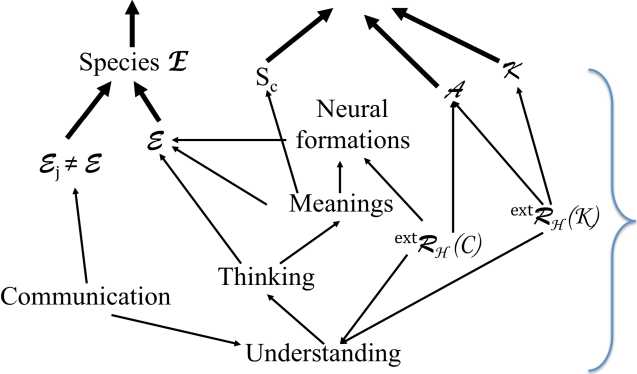Earth’s-biota ► Universe

Invariant
capabilities
and time
dependent
structures.
S stands for individual of species rE.
Sc stands for stimulus within its context. ∕√ stands for artificial
construction.
stands for an external situation. Cstands for conception,
exl¾ stands for human ability to create external representations.
Figure 1. Relations among key capabilities, structures, individuals and their
environment. Bold face arrows stand for ‘part of’; regular arrows for ‘defined in
terms of’.
A first look at Figure 1 gives the impression that the sought theory of noémona
species (TonE) is purely cognitive and hence inappropriate for the task. This is not
the case. Although the terms ‘thinking’, ‘understanding’, ‘meaning’ and
‘communication’ are associated with a cognitive (i.e., information processing)
approach, the theory redefines them (sections 2.1 & 2.2) in a way that makes the
perceptual, affective, cognitive, motivational, and action aspects of mind inseparable.
To be noted in particular that the sensory and motor systems posited in definition-1
are literally foundational in the sense that all animals possessed bodies before they
possessed nervous systems.
Equally important is the time parameter characterising all key elements of the
theory that necessitates consideration of the complex developmental aspects of the
individual. All aspects of an individual (including its unconscious) are inseparable.
The usual methodological strategy of divide and conquer is fundamentally wrong. We
need to consider all aspects of the individual however crudely at first and refine
subsequently. Refinement is necessary in order to understand nearly any phenomenon
deeply. But such division of labour should be constrained by both the inseparability
constraint and general overall principles. Naturally, the latter may change when
adequate new evidence accumulates. But such a change will reflect deeper
understanding rather than patchy additions to the results of a biased strategy. Apart
from specific arguments and proposals, an important objective of the proposed theory
is to illustrate the potential of this approach.
Finally, I want to make explicit the following two working hypotheses. First, I
adopt the mind-brain identity (MBI) hypothesis.7 Second, I will use extensively a
special case of the evolutionary compatibility constraint introduced in section one,
namely, the range of problems a ‘mental’ phenomenon may refer to depends on the
particular evolutionary period and the taxon that one is considering. This rather
obvious point has important consequences that are usually overlooked.
More intriguing information
1. The Provisions on Geographical Indications in the TRIPS Agreement2. Ein pragmatisierter Kalkul des naturlichen Schlieβens nebst Metatheorie
3. The name is absent
4. Social Balance Theory
5. Economic Evaluation of Positron Emission Tomography (PET) in Non Small Cell Lung Cancer (NSCLC), CHERE Working Paper 2007/6
6. The name is absent
7. Proceedings from the ECFIN Workshop "The budgetary implications of structural reforms" - Brussels, 2 December 2005
8. Developmental changes in the theta response system: a single sweep analysis
9. Feeling Good about Giving: The Benefits (and Costs) of Self-Interested Charitable Behavior
10. INTERACTION EFFECTS OF PROMOTION, RESEARCH, AND PRICE SUPPORT PROGRAMS FOR U.S. COTTON